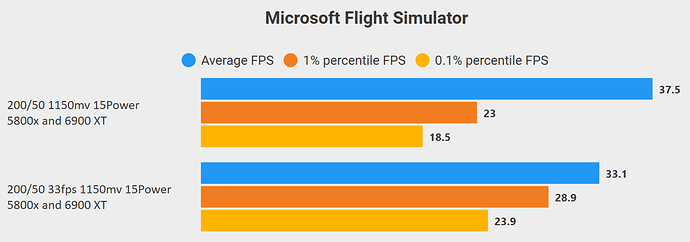Thanks for that suggestion, I will definitely give it a try as soon as life stops ilnterferrling with my flying! I think I need to express my question more explicitly. If I start increaseing the MSFS graphics options from Medium up to Ultra, how will I know when I’ve gone to far? On my 2070 it wouldn’t take much before the performance was obviously unacceptable, with tears, stutters, freezes, etc. Indeed I never had enough headspace to use an FPS counter at all. With the 6900 will it keep churning out 30 FPS and then bomb, or is there some other way to know when I’m asking to much of the card?
I use CapFrameX. It’s a free program. When you start a flight, you hit the CapFrameX keyboard shortcut and it starts measuring the game while you’re playing. When you want to finish the measurement hit the keyboard shortcut again and it stops.
Here’s an example of what you get.
You’ll see in the top graph I was using 200/50 settings as mentioned, on the 6900xt I lowered the voltage to 1150 mv and upped the power setting to 15. The lower graph is the same flight but after I capped the framerate, in this case I capped it to 33 fps. Notice what happened to the 1% and 0.1% framerates. They got a really good boost. It’s those values that represent the stutters.
So that’s how you measure your settings. You don’t need a high average fps but you need descent 1% and 0.1% low values. You’ll want to also monitor your CPU and GPU temperatures. I use HWINFO64 for that, another free program.
Good luck.
Thanks to my non-defective 6900 XT (and the help I’ve gotten here) I finally have a setup that provides smooth 30+ FPS performance and pretty ■■■■ good graphics (after literally many months of intense frustration). Now I’d like to ask if any one knows of a method or program to step by step increase a subset of MSFS settings that will let me wring the last little bit of better graphics out of MSFS? And by graphics, I mean the look of the ground more than anything else. Any kind of hierarchy ranking the settings by the ones that will provide the best images? It hasn’t been worthwhile spending the time and effort to do this previously because I kept having to go back to the defaults and work up to atolerable setup but now it is. Thanks.
Obviously it depends on your hardware as from where to start and to how high you can reasonably go but my method on a lower high end system is - Native 4k, 100% render scale and preset ultra with the usual motion blur and lens correction turned off. weather set to few clouds and flaps 1 in a 152 at 1500 feet over difficult photogrammetry (usually Wuppertal as regular trips keep it loaded in my rolling cache) Since SU7 this only gives me about 24 fps but is buttery smooth, turning vector data off and trees and grass to medium give me a few more frames(28-29). I then start pushing up the LODs from 200 and it’s very surprising how little the FPS drops all the way up. At LOD 400 I still have 25fps which looks lovely and is smooth unless I pan quickly or make sudden movements. Of course I know I could push into the UserCfg LODS but instead I settle for about LOD 360 and smooth panning even at airports. Renderscale 90 would get me 30fps but I’m really quite happy with a stutter free 25.
Ryzen 7 3800X, rtx3060 (not Ti), PCIe4 NVme 500GB, 16GB CL14 @ 3600MHz, 50Mbps
P.S. I am about to install another 16GB of ram although I doubt there will be any difference.
I’ve spent quite a bit of time trying to understand your post. I’ve got questions about the first sentence:
“Native 4K” implies to me that all these settings are in the 2D space, not VR. Is that correct? Does that matter for VR? I don’t have a 4K monitor: should i use that setting anyway? Also I don’t know what the usual motion blur and lens correction setting mean. And why did you mention the flaps setting? I don’t get the relevance. I understand that this is a lot of questions and I certainly appreciate your help.
I don’t have VR and I’m not sure I realised it was a 3D thread but don’t you guys calibrate first in pancake?
Anyway I imagine the principles will be similar but maybe not the ratios. Keep trying and I’m sure you’ll get there.
This topic was automatically closed 30 days after the last reply. New replies are no longer allowed.
